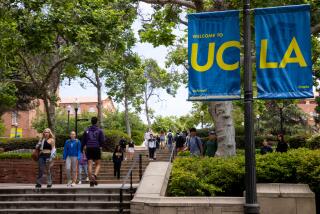From Classes to Campuses: Putting Colleges to the Test
- Share via
How do high school seniors find the college or university that’s right for them? With more than 3,000 colleges and universities to choose from, it’s not easy to make a decision.
Of course, nobody actually considers all the options. Most students begin by narrowing their choices by location, price and size. But once you’ve decided on some of the basics, how do you proceed?
Most colleges send out a view book, with glossy photographs of the campus and basic information about class size, professor-to-student ratio and a general introduction to majors and special programs.
But to really learn about a campus, ask the admissions officer for a complete catalogue of courses. Why? Because that’s where you’ll find the details.
The catalogue explains what the college requires academically, from credits needed for graduation to whether courses in specific disciplines--such as math, science or foreign languages--are required.
Students should take a look at the courses listed under specific majors--with an eye on their personal interests. For example, a student who loves literature should check to see how many courses are offered in the English department. Are there also courses in French, African or Chinese literature?
If history is a favorite subject, students should check to see if there is breadth as well as depth in the course offerings. A math whiz? Consider the balance between basic and advanced classes, and between applied math and more theoretical courses.
Students with many different interests should check to see if there are opportunities for designing an independent major that can draw in a variety of disciplines.
What if the catalogue makes you yawn? Maybe there aren’t enough courses in the subjects that interest you. Or perhaps there are too many requirements. If so, check the catalogues of other colleges and universities.
*
You can’t tell a book by its cover, or a college or university by its catalogue alone. So if you’re trying to make a decision about school, you’ll want to visit the campus to see what it’s really like.
Starting this month, many colleges invite high school students to spend a few days on campus. It’s one of the best ways to get the inside scoop on a school.
Classroom visits can tell a lot about teaching and the learning process. Choose courses dealing with the subjects you like. Look at classes you might have to take as a freshman, as well as more advanced electives.
Don’t be afraid to ask questions. Who are the favorite professors on campus and why? Ask students if they get help from professors when they need it, and if tutoring is available.
See if the classes are small enough to regularly permit student participation. Are class discussions relaxed and lively? Do students seem comfortable expressing their views, or do they seem to be saying what the professor wants to hear?
Does the professor seem to know the students on an individual basis? Does he or she take a genuine interest in what students have to say? You should get the feeling that students, their work and ideas count.
If you sit in on a large lecture class, watch the students around you. They should be listening intently and taking notes. Do students look bored? They probably are. Professors who are truly excited about what they’re teaching are lively and animated, even passionate.
See if students approach the professor after class is over. That’s a sign that students are interested in what they’re learning--and that professors are involved with their classes. Professors should also be accessible during office hours.
How closely do students and professors work together? At some colleges, students and faculty cooperate on research projects or papers.
Students, too, should work together. They may work on group projects, study together for exams or help one another after class.
Learning should also extend outside the classroom. Students who are really engaged in learning will talk about classes in the cafeteria and the dorms.
While you’re on campus, pick up as many school publications as you can. The student newspaper and student-produced magazines give a good sense of who the students are and what’s important to them.
If you ask enough questions, it won’t be hard to discover how students really feel about their school. You’re exactly where they were a year or two ago, and they’ll want to help.






